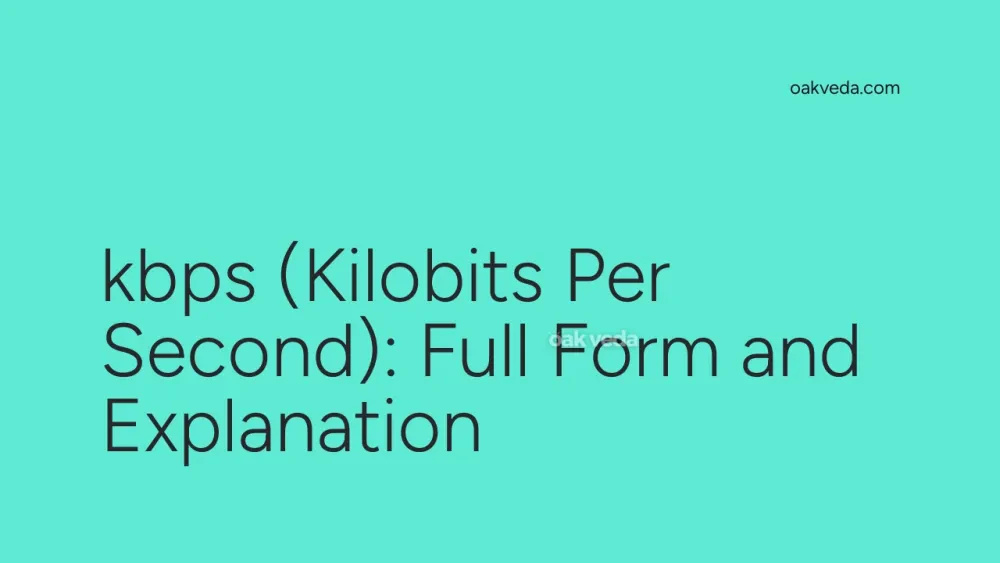
What is the Full Form of kbps?
The full form of kbps is "kilobits per second." This abbreviation is widely used in the field of data communication and networking to measure the speed of data transmission. Understanding kbps is crucial for anyone dealing with internet connections, file transfers, or digital communication systems.
What is Kilobits Per Second?
Kilobits per second (kbps) is a standard unit of measurement used to quantify data transfer rates. It represents the number of kilobits (1,000 bits) that can be transmitted in one second. This metric is essential for assessing the bandwidth of various communication channels, including internet connections, network interfaces, and data transmission systems.
Origin and Development of Kilobits Per Second
The concept of measuring data transfer rates in bits per second dates back to the early days of digital communication. As technology advanced and data transmission speeds increased, the need for larger units of measurement arose. Kilobits per second became a common metric in the 1980s and 1990s with the rise of dial-up internet connections and digital subscriber line (DSL) technologies.
How does Kilobits Per Second work?
Kilobits per second works by quantifying the amount of data that can be transmitted over a network or communication channel in one second. Here's a breakdown of the measurement:
- 1 kbps = 1,000 bits per second
- 1 Mbps (megabit per second) = 1,000 kbps
- 1 Gbps (gigabit per second) = 1,000,000 kbps
When measuring internet speeds or data transfer rates, higher kbps values indicate faster transmission capabilities.
Functions of Kilobits Per Second
The primary functions of kbps as a measurement unit include:
- Bandwidth Measurement: kbps helps quantify the capacity of data transmission channels.
- Speed Comparison: It allows for easy comparison between different internet connections or data transfer methods.
- Performance Evaluation: Network administrators use kbps to assess and optimize network performance.
- Service Level Agreements: Internet Service Providers (ISPs) often specify their service speeds in kbps or its multiples.
Applications of Kilobits Per Second
Kilobits per second finds applications in various areas of digital communication:
- Internet Connections: Broadband speeds are often measured in kbps or Mbps.
- Streaming Services: Video and audio streaming quality is determined by the available kbps.
- File Transfers: Download and upload speeds are typically expressed in kbps or its multiples.
- Mobile Networks: 3G, 4G, and 5G data speeds are measured using kbps and its higher units.
- Network Equipment: Routers, switches, and modems often specify their capabilities in kbps or Mbps.
Features of Kilobits Per Second
Key features of kbps as a measurement unit include:
- Scalability: It can be easily converted to larger units like Mbps or Gbps for higher speeds.
- Precision: kbps offers a more precise measurement for lower speeds compared to Mbps.
- Universal Acceptance: It is widely recognized and used across the tech industry.
- Ease of Understanding: The concept of bits per second is relatively easy for most users to grasp.
Benefits of Using Kilobits Per Second
Using kbps as a measurement unit offers several benefits:
- Standardization: It provides a standard way to measure and compare data transfer speeds.
- Consumer Awareness: Helps consumers understand and compare internet service offerings.
- Technical Accuracy: Offers a precise measurement for network performance analysis.
- Cross-platform Compatibility: Used consistently across various devices and systems.
Limitations or Challenges of Kilobits Per Second
Despite its widespread use, kbps has some limitations:
- Confusion with KBps: Often confused with KBps (kilobytes per second), which is a different measurement.
- Outdated for High Speeds: With increasing internet speeds, larger units like Mbps are becoming more common.
- Marketing Discrepancies: Some providers may advertise speeds in bits but deliver in bytes, leading to confusion.
Future Developments in Data Transfer Rate Measurement
As technology continues to advance, we can expect:
- Higher Units: Increased use of Gbps and Tbps (terabits per second) for ultra-fast connections.
- New Metrics: Development of new metrics to measure network quality beyond just speed.
- Standardization Efforts: Initiatives to standardize speed measurements and reporting across the industry.
FAQs on kbps Full Form
-
What's the difference between kbps and KBps? kbps stands for kilobits per second, while KBps means kilobytes per second. 1 KBps is equal to 8 kbps.
-
How many kbps is considered good internet speed? For basic browsing, 1,000 kbps (1 Mbps) is sufficient. For streaming and gaming, speeds of 5,000 kbps (5 Mbps) or higher are recommended.
-
Can kbps be converted to Mbps? Yes, 1 Mbps is equal to 1,000 kbps. To convert kbps to Mbps, divide the kbps value by 1,000.
-
Why is kbps important for streaming? kbps determines the quality and smoothness of streaming content. Higher kbps allows for better video and audio quality.
-
How does kbps relate to file download times? The higher the kbps, the faster a file will download. For example, a 10 MB file will download in about 80 seconds at 1,000 kbps, but only 8 seconds at 10,000 kbps.
Understanding the full form of kbps and its implications is crucial in today's digital age. Whether you're choosing an internet plan, troubleshooting network issues, or simply trying to grasp the basics of data transmission, knowing about kilobits per second can help you make informed decisions and better understand the technology around you.
You may be interested in:
- MRI (Magnetic Resonance Imaging): Full Form Explained
- DNA (Deoxyribonucleic Acid): Full Form and Explained
- AIDS (Acquired Immune Deficiency Syndrome)
- LED (Light Emitting Diode): Full Form and Applications
- MLA (Member of Legislative Assembly) Full Form
- IDFC (Infrastructure Development Finance Company)

